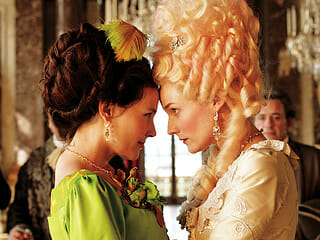
On the eve of the French Revolution, everyone is a prisoner. The starving sans-culottes are powerless prisoners of a government that parties more effectively than it governs. The royals are no better off, as their opulence does nothing to protect them from the angry radicals out to behead them, and their money squandering has rendered them prisoners of their own country. Perhaps their servants—caught somewhere in between the two worlds—are the only ones with any freedom.
Benoît Jacquot’s latest film, Farewell, My Queen, shows the court of Versailles through eyes of Sidonie (Léa Seydoux), the queen’s reader, whose sole job is to please Marie Antoinette (Diane Kruger) with her reading selections. A fresh-faced and deep-eyed mademoiselle, Sidonie seems innocent enough as she fumbles over herself to get from her stone-walled servants’ quarters to the silken boudoir of the queen in time for a morning reading. But it only takes about three seconds to realize that Sidonie is in shackles of her own. As the queen tenderly applies rosewater to relieve Sidonie’s mosquito bites, the fleeting moment of physical connection is palpable. But while this is enough fantasy for the servant to feed off of for days, it is quickly forgotten by her queen, who is in possessed by her love for the mysteriously erotic court lady, Gabrielle de Polignac (Virginie Ledoyen).
“So young and already blind,” says the court’s note-taker, Mr. Moreau (Michel Robin). Sidonie, as bookish as she appears to be, is too bound to the queen’s whims to realize that her sacrifices will never be rewarded. Unlike the delicious, poor-little-rich-girl that Sofia Coppola created in Marie Antoinette (2006), Jacquot paints the queen as a materialistic, self-obsessed diva who will dole out just enough affection to manipulate those who can help her get what she wants.
Sidonie is naïve enough to fit the role of an orphaned servant whose isolating independence makes her intoxicated with the queen’s attention. She plays up her innocence to mask her attempts to beguile; although she is nobody, she has moments of selfish boldness that could pass her off as a somebody. But at times, Seydoux’s overplays her hand when it comes to her character’s emotional palette. As a result, Sidonie is a bit too quick to tear up in moments of the queen’s rage and too wide-eyed in moments of the queen’s love. With the help of the driving music score (written by Bruno Coulais), there is a sense of melodrama that the stressful circumstances justify, but Seydoux’s heavy breathing occasionally pushes it over the top.
Kruger suffers no such lapses in her portrayal of the youth-obsessed queen. As Antoinette, the German actress is Snow White’s evil queen made flesh—drawn to pale, dark-featured beauties and mad with her desire for the one she can never have. Kruger successfully externalizes the queen’s internal loneliness through all of her layers of silk and tulle, and her bouts of rage are as convincing as her selfishness is perfectly cold. The queen knows who she does and doesn’t have under her spell—and thanks to Kruger, that spell often extends to the audience. Like a glamorous but emotionally deprived child, it’s hard not to both pity yet be obsessed with Kruger’s version of the young queen. The best scenes are the ones she controls.
As much as it is a study in Stockholm syndrome, however, Farewell, My Queen is equally a study in lighting. The rapid change between soft sunlit chambers, candlelit corridors and nighttime darkness carries the mood of the movie from beginning to end. When we first see Kruger, the white sunlight bathing a room of pale fabrics and skin make her seem wonderful and pure. Later, when the list of 286 heads to be chopped off begins to circulate, the orange shadows in the stone hallways of the servants’ quarters are suitably apocalyptic. And when Kruger gets a hold of it, the firelight that is unable to successfully light her overly large room conveys both impossible warmth and inevitable squalor. The plot is literally reflected in the light.
It’s easy to buy into the gilded illusion that possessed the court during this time of upheaval. In the excess of extraordinary clothes (fashioned by costume designer Christian Gasc) and visually absorbing scenery (filmed at Versaille and nearby palaces), the screen overflows with opulence in nearly every scene, and despite some overdramatic acting, it’s difficult to look away. But—as history recounts—it would only be a matter of time before heads would roll, and the spell of mirrored halls would be replaced with the drabber reality of the masses. In Farewell, My Queen, though, Jacquot has more fun reliving the former and keeping the latter outside his gates.
Director: Benoît Jacquot
Writer: Benoît Jacquot & Gilles Taurand (screenplay); Chantal Thomas (novel)
Starring: Diane Kruger, Léa Seydoux, Virginie Ledoyen
Release Date: July13, 2012